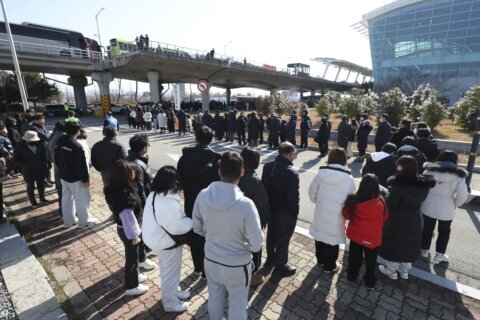When Pippa Woolven was offered an athletic scholarship to run cross country and track at her dream school, Florida State University, she was in love with the sport. Woolven moved from England to Florida having only visited the U.S. once before.
“I was so blown away by how fun it was to have this family of other people that have the same level of passion towards the sport that you do,” says the former elite athlete and CEO and founder of Project RED-S, an organization working to provide information and support to athletes struggling with relative energy deficiency in sport.
But that passion for the sport slowly transformed into months of illness, consistent injury and overwhelming fatigue. At first, Woolven thought these symptoms were “just part of being an athlete.” But she became worried as the illness, injury and fatigue accumulated.
“I did get to a point where I just thought, ‘There’s something more the matter here,'” she says. “This isn’t just being an athlete. I haven’t been able to string together weeks of training. The fatigue was what really hit me. It became so all-consuming that I couldn’t push through it.”
What Woolven was experiencing was relative energy deficiency in sport, or RED-S for short, a condition that occurs when an athlete expends more energy than they take in through food. When this happens, an athlete is using so much energy to perform their sport that their body doesn’t have energy left over for other necessary functions: fighting off infection, rebuilding bone, regulating emotions, building muscle, maintaining a menstrual cycle and more.
While RED-S may be an unfamiliar term, some people may have heard of the female athlete triad syndrome, a related but older term for a similar idea.
[READ: Mind-Blowing Benefits of Exercise: Why Exercise Is Important]
What Is the Female Athlete Triad?
The female athlete triad describes a group of conditions that impacts female athletes and is often related to intense training and focus on weight or body composition.
The three interrelated conditions that make up the female athlete triad are:
— Disordered eating: taking in fewer calories than you need during the day
— Dysmenorrhea: menstrual cycle irregularity
— Osteoporosis: low bone mineral density
The term was first coined in 1992 by the American College of Sports Medicine, after experts started noticing these three conditions in highly athletic women.
Female athlete triad symptoms
Disordered eating
Athletes with disordered eating patterns may restrict food intake, obsess over calories, skip meals, be constantly preoccupied with weight or measurements or induce vomiting. These behaviors are often the result of sport-related pressure.
In some sports like ballet or gymnastics, pressure comes from expectations that athletes look a certain way. In other sports like distance running or rock climbing, sport culture has emphasized the importance of weighing less in order to perform better.
Dysmenorrhea
Dysmenorrhea, a condition characterized by menstrual cramps and pelvic pain, or amenorrhea, a condition in which there is an absence of menstrual periods, can occur because of disordered eating. When your body is not fueled properly, it stops producing the hormones necessary for a normal ovulation cycle. Instead, your body prioritizes using the limited energy it has for necessary survival functions.
Studies show that among women who participate in sports that emphasize leanness, like ballet and running, the prevalence of abnormal menstrual cycles is up to 69%, compared to only 2% to 5% prevalence in the general population.
This symptom is sometimes complicated by the use of birth control. Athletes who use hormonal birth control might have a regular period because of the supplemented hormones, but could still be experiencing other symptoms of the female athlete triad.
Osteoporosis
While often associated with aging and older adults, athletes experiencing the female athlete triad can develop low bone mineral density at a young age, which can result in recurrent bone fractures or stress fractures.
Disordered eating and dysmenorrhea can both lead to osteoporosis. Underfueling or being calcium-deficient can both lead to bone weakening, and having irregular periods leads to low levels of estrogen, a vital hormone for bone-building.
[READ: Signs of a Hormonal Imbalance.]
What Is RED-S?
In 2014, the International Olympic Committee released a consensus statement on relative energy deficiency in sport, bringing the term RED-S into the spotlight. While the female athlete triad refers to the specific set of three symptoms that affect female athletes, RED-S is a broader term that describes numerous health impacts of low energy availability, or LEA, across genders.
LEA occurs when the energy that an athlete uses during exercise is greater than the energy that they take in through their diet, which leaves the body without the necessary energy to perform other vital functions.
The hormonal effects of RED-S are what underlie some of the symptoms.
“If your body is not fueling enough, it will shut down secondary processes in the body so that it can conserve energy,” says Abby Olcott, a sports dietitian and the owner of Midwest Performance Nutrition.
Shutting down those secondary processes can result in a variety of the symptoms of RED-S, including psychological issues, fatigue, dysmenorrhea, low bone density, gastrointestinal issues and more.
RED-S symptoms
Because RED-S is a condition that affects the entire body, its symptoms can vary widely and affect several systems of the body.
Several ways that RED-S can affect the body include:
— Increased injury risk
— Depression, anxiety and irritability
— Loss or dysregulation of menstrual function
— Decreased muscle strength
— Iron deficiency
— Gastrointestinal issues
— Reduced athletic performance
Increased injury risk
One of the most obvious effects of RED-S can be seen when athletes are frequently injured and, particularly, have a higher incidence of stress fractures, which are small fractures often caused by repetitive impact like running. Because of their small size, stress fractures are rarely seen on normal X-rays.
When an athlete isn’t fueling enough, their body will stop producing estrogen.
“The same hormones that control your menstrual cycle also control your bone density,” Olcott explains. “If you’re not making those hormones, then your bone density suffers, which puts you at risk for stress fractures.”
While osteoporosis is usually diagnosed in older adults, athletes with RED-S can end up with osteoporosis as teenagers.
Depression, anxiety and irritability
Athletes with RED-S are more likely to be clinically depressed or anxious or have other mental health conditions.
Mental health conditions — like anorexia, OCD, anxiety and others — can contribute to the disordered eating that causes RED-S, but RED-S also limits energy to the brain and disrupts hormone levels, which can itself cause mental health issues.
Loss or dysregulation of menstrual functionStudies have shown that athletes with low energy availability are more likely to have amenorrhea or dysmenorrhea. When an athlete’s body doesn’t have the necessary energy available for regular functioning, it will prioritize survival functions and deprioritize other bodily functions, including menstruation.
Decreased muscle strength
When an athlete has RED-S, they often struggle to build or maintain muscle strength. Studies show that this is potentially a hormone-mediated relationship, since estrogen is a key component in muscle building. When an athlete’s hormone levels are altered by energy deficiency, they’re unable to build and maintain muscle mass.
Iron deficiency
Iron deficiency is a common problem among athletes, and can be worsened by RED-S. Low nutrient intake and hormonal dysregulation can both lead to low ferritin levels and iron-deficiency anemia. It’s possible to increase iron levels by eating iron-rich foods or taking iron supplements.
Gastrointestinal issues
A 2018 study showed that athletes with low energy availability also have higher incidence of gastrointestinal issues, including constipation and stool leakage
Reduced athletic performance
All of these issues contribute to worsening athletic performance, which is most often the factor that leads an athlete to finally seek help for their condition. Keay says that hormones like estrogen that are dysregulated by RED-S are also vital for cognitive function. Dysregulation of hormones in the human body can have direct impacts on peak performance.
“Studies show that if you haven’t got periods or are amenorrheic, you have a slower reaction time and lower peak power production.”
[READ: Ferritin Blood Test Information.]
Female Athlete Triad Syndrome vs. RED-S
The female athlete triad is only a subset of the conditions that RED-S encompasses.
The term RED-S recognizes that LEA can affect athletes of any gender and that the symptoms impact many more bodily functions than initially recognized. RED-S is a more accurate, less stigmatizing term, Woolven notes.
“It can be temporary, you can be in a relative energy deficiency for an hour or a day. But we don’t want this to be (portrayed as) something that you can never recover from, or that once you’ve had it, you’re labeled with it for life,” she says.
[SEE: How to Improve Your Focus and Athletic Performance.]
Female Athlete Triad and RED-S Causes
While RED-S and the female athlete triad are caused by the combination of underfueling and intense physical activity, there are several factors that affect an athlete’s fueling and training decisions.
Unfortunately, in some sports, it’s the pressure to look a certain way or have a specific body composition that impacts the development of RED-S. Athletes in sports influenced by body weight — like running, climbing or cycling — or sports that place value on aesthetic performance — like ballet or gymnastics — are most affected by these pressures.
Olcott, who has been a runner for much of her life, was in junior high school when she first heard someone say that “girls run faster when they’re lighter up top.”
“The message was always clear from the beginning in running that lighter equals faster equals better,” she adds.
The experience of underfueling in an attempt to perform better is widespread across a variety of sports and has persisted for generations.
“When I was 10, I had an eating disorder. Now, we would look back and (understand I) had an eating disorder and part of RED-S, because I was wanting to be slim for ballet,” says Nicky Keay, a sports and dance endocrinologist and author of “Hormones, Health and Human Potential.”
Ultimately, Keay explains that there are three key athletic behaviors: nutrition, the exercise itself and recovery. When these behaviors are out of balance and an athlete is not sleeping or recovering well, or when an athlete’s nutritional habits aren’t getting them the energy and nutrients they need, they might start noticing RED-S symptoms.
What Kind of Athletes Are at Risk?
While the female athlete triad specifically references athletic women, the transition to the concept of RED-S places importance on the fact that anyone can be impacted by the effects of low energy availability. Research shows that recreational athletes, men and older athletes are also at risk for RED-S.
While younger and middle-aged athletes are at risk for RED-S, Keay says she’s seeing it in older athletes as well.
“RED-S can happen at any time,” she says.
Sometimes, when athletes start to gain age-related weight in their 40s and 50s, they begin dieting, but inadvertently end up in an energy-deficient state.
Even if an athlete has had a positive relationship with food for their entire life and has never experienced energy deficiency before, that can change with a change in environment or training type.
Woolven had heard of the female athlete triad before starting college and says that even after noticing disordered eating behaviors in her teammates, she never thought that it would impact her.
“I was a very balanced person,” she says. “I was obsessed with chocolate and cake and whatever. I just never thought I would be the one to start restricting. But then as time wore on, and I became more and more invested in my performance and maximizing the opportunity to be in America, I did start to think ‘Well, maybe if I more like these guys, I’ll be as fast as them.’ And they were better than me, which was tough, because you do start to look at that as an example.”
Early Warning Signs of RED-S
It’s not always easy to see warning signs of RED-S in yourself — or even in other people. Some of the behaviors associated with the female athlete triad and RED-S come on slowly or are even ingrained in the culture or traditions of a team or of an entire sport.
“Initially, it starts off so subtly,” Woolven says. “You just simply cut out the things that society deems to be unnecessary. We had this culture of clean eating that was actively encouraged by the coach and the rest of the team, so you think you’re doing all the right things by cutting out the chocolate after dinner and the extra chips on the side.”
But as those nutritional changes turn into even more restrictive eating habits, athletes start to see changes in their body and performance, some of which initially seem like positive changes.
As she spent more time dedicated to running in the U.S., Woolven realized these nutritional changes were becoming more exaggerated.
“It would be things like going from a whole cup of oats for my porridge to half a cup,” she says. “Then, I did start to think ‘I know that this isn’t enough (food), but it’s making me skinny, and it’s making me fast. And it’s working.'”
Those changes that initially seem like they’re resulting in reduced weight and faster running can turn into the fatigue, bone injuries, immune system weakness, amenorrhea and more that make up the condition of RED-S.
While it might be possible for someone to recognize these symptoms in themselves, team members and friends might see it in an athlete first, and it can be a difficult topic or conversation. But one of the most helpful and important things that athletes can do to help is to talk about it with each other.
Female Athlete Triad and RED-S Prevention
In a perfect world, athletes would be able to prevent RED-S by consuming as much energy through food as they expend during exercise. But it’s not that simple.
“RED-S isn’t suddenly going to vanish because, by the very nature of the training to be a dancer or sports person, you’re already a perfectionist: driven, motivated and self-critical,” Keay says. “These are all the characteristics where you might end up having disordered eating. Nevertheless, that doesn’t mean that doing activity is bad for your health.”
Instead, Keay says that the key is to make sure athletes understand how to fuel their bodies in an effective way, and to think about food as fuel rather than something that could cause weight gain. And while it might be hard to ask for help, a registered dietitian can be a life-changing resource in learning how to fuel for sport.
“As your RD, I’ve seen it all from all ends of the spectrum. I am not out to judge you. I’m not out to tell you what to do,” Olcott says. “I want to be your partner in this journey to help guide you to better nutrition habits for you.”
In addition to available knowledge and resources, team culture and positive role models can make all the difference in preventing others from developing RED-S. Recognizing this desperate need for information and conversation about RED-S, Woolven began sharing her story and compiling information and resources onto a website, which eventually became Project RED-S.
While it was daunting to express her personal vulnerability, Woolven felt that sharing her story was important in her mission to help other athletes.
“Because it resonated with so many other people that were saying they’d had the exact same experience, I couldn’t not (share my story),” she says. “That was really powerful to see so many people say, ‘I think I’ve had the exact same issue.'”
More from U.S. News
Exercises Trainers Would Never Do
Best Personal Training and Workout Plan Apps
RED-S and the Female Athlete Triad originally appeared on usnews.com
Update 06/06/24: This story was previously published at an earlier date and has been updated with new information.







